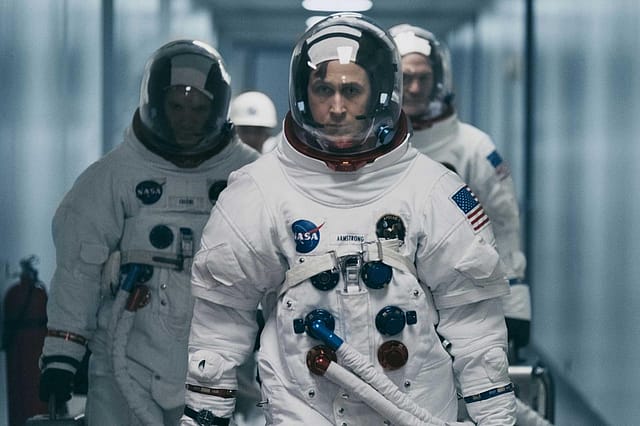First Man Movie Review

This is one of the most interesting American films on the relationship between technology and the human mind. The movie's visual and sound design adopts an almost entirely subjective perspective, with only occasional objective scenes, to show us how a pilot or an astronaut experiences high altitude air or space flight, from the ground up. It is absolutely unlike a film like 'Gravity', which objectifies and dresses up space with film technology, to make it look aesthetic.
Here, the focus is on the selected individual, Neil Armstrong (Ryan Gosling), the first man to walk on the moon, and on his approach to technology. Armstrong was a civilian test pilot and an engineer, and his peers, particularly Chuck Yeager, had a few things to say about engineers who fly planes – mainly that they have too mechanical a way of piloting, and do not use their flying instincts. Instead, they tend to sort out problems with the help of their aeronautical learning.
And yet, it appears that in piloting planes and spacecraft that were new and that had not been tested sufficiently, and in finding solutions to technical problems that the makers of this technology themselves had not anticipated, this aptitude was the correct one for survival.
There are three flights that involve Armstrong in the film, and in each one we look at the machines as they affect his mind – only incidentally looking at the spectacular view outside. In the cramped space of a cockpit or a space module, the test pilot or the astronaut is dealing with the tangible fear of the unknowable, and is subject to an enormous gravitational pull that makes him unable to appreciate, or even contemplate, the beauty of the universe outside. This is the perspective that 'First Man' gives us; the frightening shake and rattle of primitive machinery made of steel and cables that has to withstand the forces of aerodynamics, even as the puny vehicle commanded tears away from gravity, or enters it too quickly and dramatically.
Dharmendra
28 Nov 2025 - Vol 04 | Issue 49
The first action hero
What director Damien Chazelle does very effectively is to cut off the sound track entirely, when he wants you to focus outside the mind of Armstrong. The single most stunning shot in the film is when the commander has landed the 'Eagle', Apollo 11's lunar module, on the surface of the moon. As he opens the hatch for his moon walk, there is dead silence, not even the sound of the astronaut breathing. Then, a heavenly view unfolds. It is a remarkable poetic transition from subjectivity to objectivity, both for the viewer of this extraordinary sight (Armstrong), and for ourselves, via the curved IMAX screen in front of us. This single shot, held for 30 seconds or more, closes the gap between the astronaut and the audience, and shapes a perfect identification of what the surface of the moon first looked like to a member of our species. The dead silence on the sound track is only broken by a sharp intake of breath from the audience.
On the ground, there is little communication between Armstrong and his wife Janet (Claire Foy). She knows that she is married to a man who, mathematically, has about a fifty percent chance of coming home from each mission he is on, during those early desperate years of the space race. Armstrong seems to deliberately withhold himself from marital affection, and even when he comes back successfully as an international celebrity from his last mission, Apollo 11, there is silence when the couple meet outside the quarantine chamber. They prefer to look at the floor. She accepts that she is married to a withdrawn man who speaks in short and abbreviated sentences, the better perhaps to survive the perils of his vocation. She herself, though, is quite voluble, and lets out steam by castigating the NASA engineers, describing them as a bunch of boys playing with balsa wood toys, endangering the lives of her husband and other astronauts like him. The sheer oddity of marriage to a man like him, is well described in the film.
The American flag is shown on the surface of the moon, but not the astronauts raising it, which has raised some nationalist hackles. In fact, this is perfectly in synchrony with Armstrong's first words when he sets foot on the moon, speaking of one small step for a man, and one giant leap for mankind. He never said anything about a giant leap for an American, did he?
All said, 'First Man' is a fine cinematic experience, one not to be missed.
